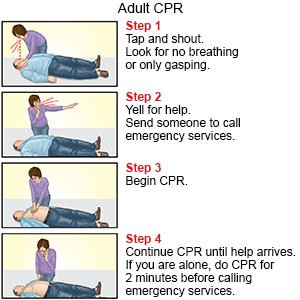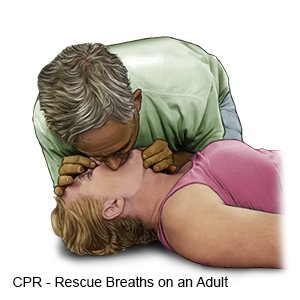Lay Person CPR On Adults
Medically reviewed by Drugs.com. Last updated on Sep 23, 2025.
What is lay person CPR on adults?
Lay person cardiopulmonary resuscitation (CPR) is an emergency procedure performed by a person who is not a trained healthcare worker. CPR may combine chest compressions with rescue breathing or may be chest compressions only. A chest compression means you push on the person's chest. Rescue breathing means you give breaths to the person through his or her mouth.
What are some important things to remember about CPR for adults?
- Call your local emergency number (911 in the US) before you start CPR. Get emergency help to the person as quickly as possible. If you are with another person, one person can start CPR and the other can call or go for help.
- Learn the steps used to give CPR to adults by remembering C-A-B. This stands for chest C ompressions, A irway, and rescue B reathing.
- Do chest compressions even if you cannot give rescue breaths. Chest compressions alone make it more likely that the person will live than if you do nothing at all.
 |
What should I do if I find a person who is not breathing normally?
- Make sure the area is safe to enter, and approach the person. Tap the person's shoulder. Ask loudly, "Are you okay?" Move him or her if the area is dangerous, such as in a fire. You may have to move the person to a firm surface if he or she is on a soft surface, such as a sofa or mattress. He or she needs to be on a firm surface for chest compressions to work correctly.

- Kneel beside the person. Look to see if his or her head, neck, or back may be hurt. Carefully turn the person onto his or her back while you support the head and neck. Keep the person's body straight as you turn him or her.
- Call or go for help if the person is not breathing or is only gasping.
- Begin CPR. Do 30 compressions immediately. Then open the person's airway. Hold the airway open and give 2 rescue breaths. A cycle is 30 chest compressions and 2 rescue breaths. Continue CPR cycles until the person responds, help arrives, or an automated external defibrillator (AED) becomes available. An AED is a device that gives a person's heart a shock if it is needed. AEDs are often kept in public areas and are usually mounted to a wall.

Related medications
How do I give chest compressions?
Chest compressions press the heart between the spine and sternum (breastbone). This forces blood out of the heart and to the person's brain and body.
 |
- Kneel beside the person's chest. Put one of your hands on top of the other. Put the heel of your bottom hand in the middle of the person's chest, just below the nipple line. Point your fingers up, and keep them off the person's chest. Do not lay your fingers on the chest, because you may do compressions in the wrong place. Incorrect hand positioning can break the ribs during compressions.
- Lock your elbows with your arms straight. Your shoulders should be directly over the center of the person's chest. Look down at your hands.
- Press straight down on the sternum at least 2 inches (5 centimeters). Do not push your hands forward when you press down. Go only up and down. The compressions should be constant and equal. This means that it should take the same amount of time to press down as it does to go back up. Allow the chest to relax completely between compressions. This allows blood to come back into the heart before you compress again. Leave your hands on the person's chest in the correct hand position between compressions.
- Do 30 chest compressions at a rate of at least 100 to 120 every minute. Push hard and push fast. Hard, fast compressions are more likely to keep the person's brain and heart alive. Count the compressions out loud to help you do them at a steady, even speed.
How do I open the person's airway?
- Put 1 hand on the person's forehead and press firmly backward to tilt his or her head back. Do not place your hand on the back of his or her neck to tilt the head.
- Lift the person's chin with your other hand. Hold his or her mouth open. Do not press deeply into the soft tissue under the person's chin, because this can close his or her airway.
- Look into the person's mouth for something that may be blocking his or her airway. If you see something that looks easy to get, carefully scoop it out with your finger. Do not put your fingers in the back of the person's throat unless you see something to remove.
How do I give rescue breaths?
Do not stop chest compressions for more than 10 seconds to deliver 2 breaths.
- Gently pinch the person's nose closed. This stops air from escaping through the nose. Take a deep breath and put your lips around the person's mouth, making an airtight seal.

- Give 2 breaths (1 second for each breath) into the person's mouth. The person's chest will rise each time you give a rescue breath if his or her airway is open. Do not give large breaths. Do not breathe hard or fast. Take a normal breath for yourself after each breath you give.
- Change the person's head position to reopen his or her airway, if needed. If you cannot get air in, the airway may be blocked by food or another object. Look again to see if you find an object you can remove.
Where can I find more information about CPR?
- American Heart Association
7272 Greenville Avenue
Dallas , TX 75231-4596
Phone: 1- 800 - 242-8721
Web Address: http://www.heart.org
Care Agreement
You have the right to help plan your care. Learn about your health condition and how it may be treated. Discuss treatment options with your healthcare providers to decide what care you want to receive. You always have the right to refuse treatment. The above information is an educational aid only. It is not intended as medical advice for individual conditions or treatments. Talk to your doctor, nurse or pharmacist before following any medical regimen to see if it is safe and effective for you.© Copyright Merative 2025 Information is for End User's use only and may not be sold, redistributed or otherwise used for commercial purposes.
Learn more about Lay Person CPR On Adults
Care guides
Further information
Always consult your healthcare provider to ensure the information displayed on this page applies to your personal circumstances.
